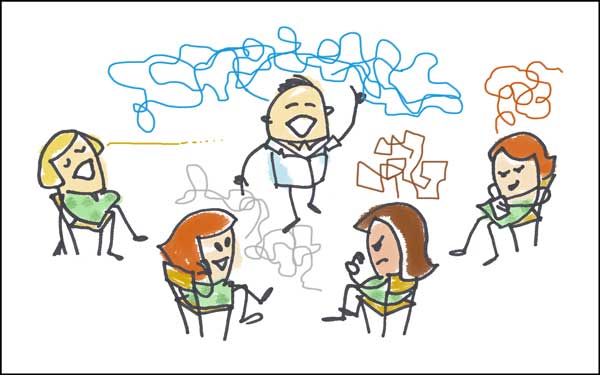When Bad Meetings Happen to Good People

– 10 Patterns that Destroy Effective Meetings –
Okay, so this isn’t a clinical article. It isn’t even about treatment presentation skills or chairside efficiency. But the information will have an impact on the daily activities in your office and your practice productivity.
My years in-office consulting has given me the privilege to observe many offices. I have the honor of working with outstanding clinicians and talented team members. In my experience, the most successful
practices combine exceptional leadership and dedicated auxiliaries. By providing opportunities for growth with ongoing training and ever-improving systems, these practices seem to soar effortlessly. But, this all doesn’t happen by chance or luck. It requires vision and dedication, strategic planning and communication. There must be time away from the chair to accomplish these.
“Away from the chair” is not the favorite place in the office for most dentists. Business planning, facilitating team meetings, or working through personnel issues places many dentists in a zone of discomfort. Sometimes, in addition to giving advice about how to run things well, it can be useful to add a hit list to help you identify when things are less than productive. Meetings can be hugely productive, especially if you avoid these Ten meeting busters:-
1. No Agenda
When there is no agenda, there is no opportunity to prepare, no framework for the meeting and no purpose. When this happens a lot, there is a tendency for falling into number 5 below.
2. Wrong people there
Ever been to a meeting where there was no logical purpose for you to be there? Meeting time is valuable so it is important for efficiency and effectiveness that as few people attend as purposeful. People should appreciate that non-attendance at a particular meeting is OK and get used to it. There are times in the practice for all team meetings and times to break the team into smaller focus groups to create a faster and more effective change in certain areas of the practice.
3. Overrun
Those times when you sit in a meeting and watch your life slip away, are those that happened with poor meeting management. Nothing is accomplished. The same items continue to be hashed out with no resolution. There is nothing worse than lack of follow through and no accountability.
4. No discipline
Some meeting participants do not know how to behave. These are things about them and their ego, lack of self-confidence and poor behavior (outside the meeting too) that is destructive to meeting progress. Lack of courtesy, understanding and space for others to say their piece is inexcusable and not constructive for any outcomes.
5. The Leader Leads
Here the meeting is at the beck and call of the leader or chair who really is holding court for themselves. This sort of meeting is supposed to appear that there is a democracy present, but there is nothing of the sort. This is a rubber-stamping meeting and is of little or no value. This is when a decision has been reached and the team needs to be informed. The same information can be provided in a memo or brief announcement.
6. The Leader Doesn’t Lead
Here there is free-for-all, with no leadership from the chair. Poor behaviors, timekeeping and no outcomes riddle this sort of meeting, with no measurable results and frayed-tempered, frustrated people. The team wonders why they showed up. The doctor wonders why he or she didn’t prep some teeth in the same time allotted.
7. Environment
Too hot, too cold, no water, no breaks, too big, too small. Have you ever been in one of those meetings? And aren’t they awful, so awful in fact that you can’t do your best. This is a meeting where the organizers do not respect the participants.
8. Nothing Happens
A lovely chat, a few disagreements and ‘see you next month’. This is the nice-to-have meeting which does nothing and goes nowhere.
9. Side-tracked/New Stuff
With an agenda, people know what the meeting will be about – or will they? Even with the best agenda, weak processes tend to leave room to new issues, side-tracking and wasted time. This is solvable with effort from the facilitator.
10. No Review and Growth
Meetings come and go and can be awful. They are unproductive, boring, overrun and people are there who shouldn’t be. If there is no review of just how good or bad the meeting has been, there will be no improvement. The leader/facilitator can add in meeting feedback as the first agenda item and stick to it – tough at first but gets easier.
Step by step, you can work, with a facilitator or not, to unravel just what needs to change. You will make a big difference, not only to meetings and how productive they are, but also to your capacity to build great relationships with the people who show up.
